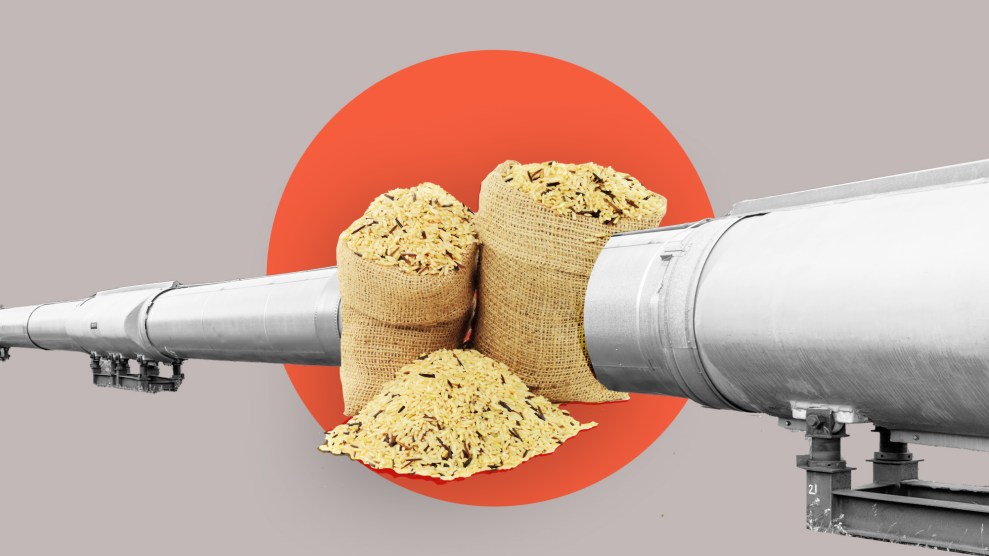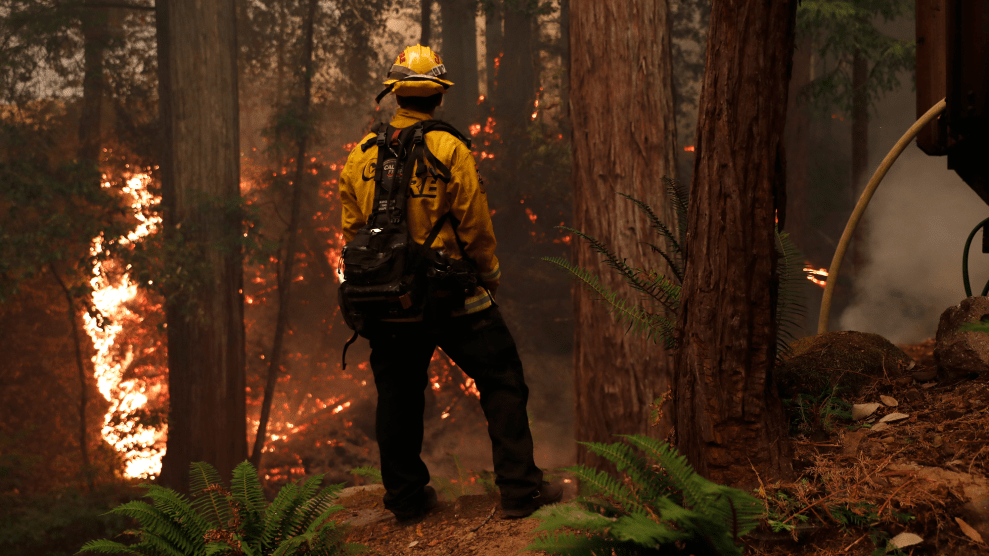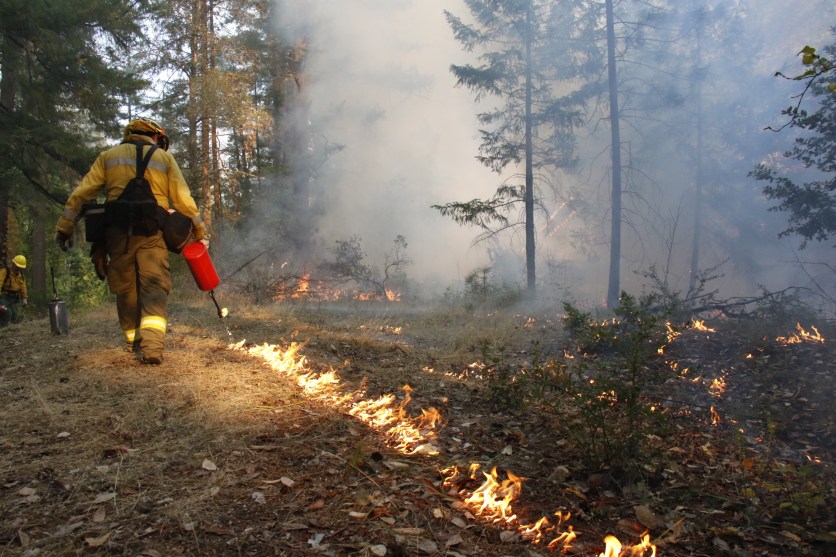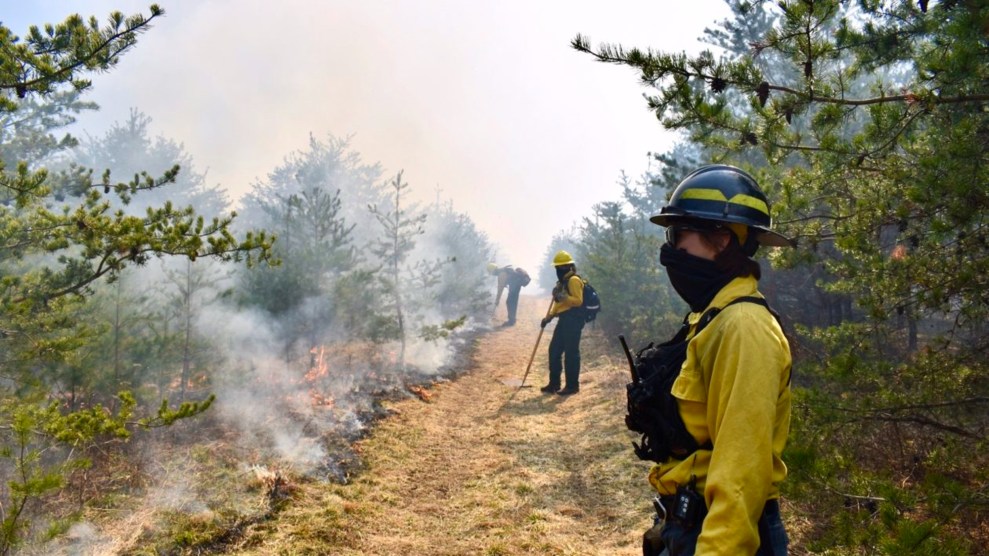
Nature Conservancy staff administer a controlled burn at their Sideling Hill Creek Preserve in western Maryland in 2021. The Nature Conservancy
This story was originally published by Yale Environment 360 and is reproduced here as part of the Climate Desk collaboration.
It’s an apocalyptic scene that has become all too familiar in recent years. Columns of thick black smoke rise from the land, turning the piercing late winter sun an otherworldly orange. The acrid smell of burning grass and trees wafts in the wind as dry stalks and dead trunks crackle and pop.
By sunset on this cold February day, the flat, low-lying landscape on Maryland’s Eastern Shore has been charred black as far as the eye can see, with a few licks of flames still working their way through small trees and fence posts.
But this is no climate change-fueled disaster. Quite the opposite: It’s an example of what ecologists call “good fire.” And Jeff Kirwan, whose 178-acre property we’re standing on, is thrilled by the flames ripping through his land. By clearing last year’s detritus, the fire will let sunlight hit the ground, stimulating marsh grasses to grow faster in the weeks ahead. Their roots will sequester carbon underground and, Kirwan hopes, build soil to keep the marsh above the surging water; sea level is rising faster here in the Chesapeake Bay region than almost anywhere on Earth.
The fire will especially encourage a type of native marsh grass called three-square, whose roots muskrats like to eat. Muskrats, which feature prominently in Indigenous creation stories in this part of the world, have long been prized here for their meat and fur by Native and non-Native people alike.
Kirwan, an emeritus professor of forestry at Virginia Tech, is one of those Native people. A member of the Nause Waiwash Band of Indians indigenous to the Eastern Shore and now headquartered in nearby Cambridge, he often returns to the shore in winter to set muskrat traps. And he remembers his father showing him marshes burning as a child. “He said, ‘This is something we learned from our Indian ancestors that we continue to do today,'” Kirwan recalls.
Kirwan is far from the only one wanting to see more flames. A growing movement of scientists, land management agencies, conservation organizations, and Indigenous groups is working to return fire to marshes like this one and to fire-adapted forests and grasslands throughout the United States. In the eastern U.S., where wildfires burn far less land than in the West, fire’s century-long absence has upended ecosystems. Forests once dominated by fire-adapted trees like oaks, hickories, and pines have been taken over by species that support far less wildlife. And overcrowded trees growing in woods without regular fire have stifled understory biodiversity, while raising the risk of damaging blazes.
“It’s really hard to express the extent to which our natural areas have been drastically altered by taking away fire,” says Deborah Landau, an ecologist with The Nature Conservancy who helped plan the burn on Kirwan’s property.
But fire promoters face stiff challenges. Relatively few people today are trained and qualified to burn. And everything from weather to government regulations to public hostility to fire conspires to keep fire off the land. A long-held view of fire as unnatural and threatening—amplified by dramatic images of climate change-fueled megafires in the western U.S. and elsewhere—is proving hard to overcome.
Advocates say that view is misguided. Prescribed fire, they say, is a critical solution to address a panoply of stark and growing challenges: biodiversity loss, wildfire risk, climate change, threats to human health, and more. Ecologists say fire is a creative force that has long produced food for wildlife and humans and has helped maintain a balance allowing multitudes of species to thrive. “Fire,” says Landau, “is as natural as rain.”
Flames once regularly touched nearly every square foot of what is now North America. Some blazes were started by lightning strikes. But most, scientists now believe, were set by humans. Indigenous people who inhabited this continent for millennia were sophisticated fire masters, using it to promote food-bearing plants, clear hunting and travel paths, create farming plots, control pests and diseases, and much more. From the oak woodlands of California to the undulating prairies of the Midwest to the vast pine savannas of the South — name the ecosystem, it was probably shaped by fire.
But as Native people were pushed out, and as forests and other landscapes were integrated into global markets, fire came to be seen as a destructive force that could wipe out valuable resources, such as timber. Fire suppression also became wrapped up in the effort to suppress Native culture.
“The Forest Service dismissed [Native peoples’ use of fire],” says Arizona State University fire historian Stephen Pyne. “That really goes back to a very strong, European elite suspicion about fire.”
While fire suppression and exclusion curtailed disastrous wildfires, at least for a time, they set in motion a cascade of other problems. Those are now coming to a head most intensely in the western US, where drought-stricken forests have become densely packed tinderboxes.
The eastern half of the continent is also suffering from a lack of fire, in ways perhaps subtler but no less profound. Research suggests that most of the eastern U.S. historically saw fire at least every three decades. Without fire, valuable ecosystems are now at risk. Among them is the longleaf pine savanna, which once covered vast areas of the Southeast, providing critical habitat for the now-endangered red-cockaded woodpecker, which nests only in holes in mature pine trees, and for a dizzying array of understory plants. The trees and plants need frequent fire to clear out competing species and encourage cones to open and drop their seeds. From pre-European times to the 1970s, the longleaf pine ecosystem shrank from some 90 million acres to 3.4 million acres.
Fire in the East is slowly increasing as more land managers—both public agencies and private owners—start to burn again. In Florida and a few other Southeastern states, landowners burn millions of acres annually. But most of the East still receives far less fire than it did historically.
“There are literally millions of acres that need to be burned per year,” says Jesse Wimberley, coordinator for the Sandhills Prescribed Burn Association in North Carolina. “It’s going to be a huge cultural shift.”
Oak-hickory-chestnut forests, a bedrock ecosystem for biodiversity in much of the eastern U.S., are adapted to fire. When such forests don’t burn, less fire-tolerant trees like red maple, beech, and sweetgum often take over. Their flat leaves form damp mats that can suppress flames, and their seeds feed far less wildlife than fat- and protein-rich acorns, hickory nuts, and walnuts.
It’s not just trees and animals that suffer when flames vanish. Eighty percent of a forest’s diversity is in its understory, and many species have evolved to grow in open, sunny patches, both in forests and in native grasslands and prairies that stretch through the midsection of the U.S. Wild blueberries, huckleberries, and many other native food-bearing plants grow better after a fire.
The transformation unleashed by fire suppression “is a very serious ecological event,” says Marc Abrams, an ecologist at Pennsylvania State University who brought attention to the issue in a highly cited 2008 paper. “Forests are undergoing a sea change unlike what’s happened for thousands and thousands of years.”
Landau calls it an ecological crisis. Rare Eastern species such as table mountain pine, whose cones need fire to open, and Canby’s dropwort, a delicate white-flowered wetland plant, could disappear from places that don’t burn, Landau fears. Studies she and others have led have found fewer bats and birds in forests that are not regularly burned, perhaps, she thinks, because the trees grow too densely for flying creatures to navigate.
And yet, it’s not just about biodiversity. While the East has so far escaped the megafires that now torch the West, thanks to plentiful rain, wildfires do occur, as a recent blaze in northern Florida made clear. Climate models predict more intense droughts that could dry out soils and stress trees such as maple, which has a shallow root system adapted to wet ground. Ecologists fear that climate change could render Eastern forests — increasingly dominated by densely growing, drought-intolerant trees — far more vulnerable to future wildfires, potentially bringing California-style blazes to places like the Mid-Atlantic. Prescribed burns could lower that risk by thinning forests and helping restore more resilient trees like oaks and pines, ecologists say.

Before a controlled burn at Maryland’s Plum Creek Preserve in January 2020.
The Nature Conservancy
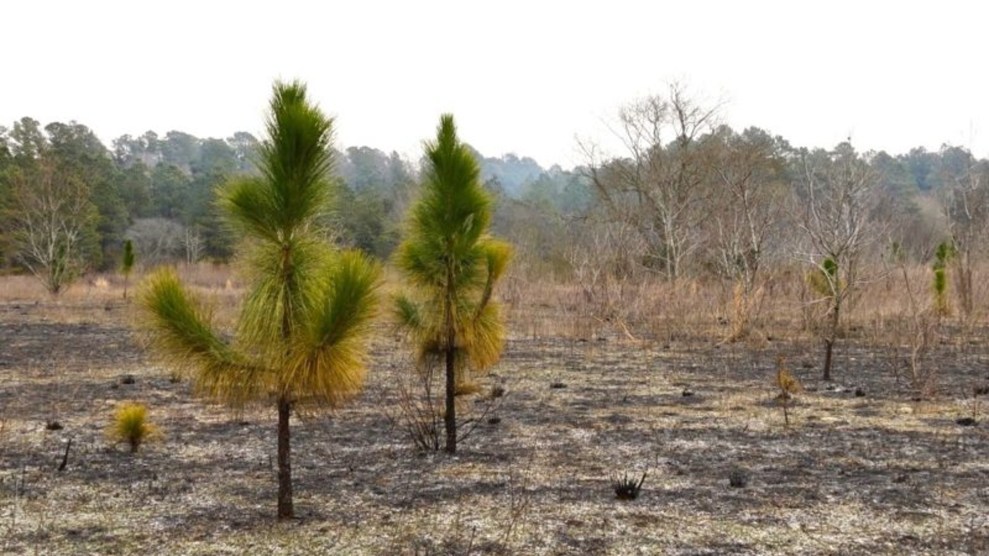
After a controlled burn at Maryland’s Plum Creek Preserve in January 2020.
The Nature Conservancy
Lack of fire may even be harming public health. Recent research suggests that prescribed fire can dramatically lower an area’s population of disease-spreading ticks, including those that carry Lyme disease, which has spread rapidly in the era of fire suppression.
Citing botanist Cecil Frost, who has studied the impact of fire suppression on plant communities, Forest Service ecologist Beth Buchanan puts it this way: “Fire suppression is one of the unrecognized ecological catastrophes of the 20th century…it’s a huge deal.”
It may seem counterintuitive that fire, so famous for consuming trees, can be good for plants. But trees like oak and pine don’t just tolerate moderate levels of fire; they thrive on it. Oaks’ tough, rumpled leaves and pines’ terpene-filled needles ignite easily and draw flames across the forest floor. Their thick bark is unperturbed by ground-hugging flames that eat through thin grasses and shrubs, and their seedlings thrive in the sunny clearings that fires create. Many fire-adapted understory plants, meanwhile, have deep underground roots that can hide from flames, soak up nutrients in ash left by a fire, and send up green shoots as soon as flames have died down.
Promoting such plants is why Landau and some 20 other Nature Conservancy and Maryland Department of Forestry employees gathered last month about an hour’s drive from Kirwan’s marsh to torch some of their own forests.
On this cold early spring morning, the team hoped to turn a 100-acre pine-oak forest with dense underbrush into a more open forest including hickories, blueberries, and a greater proportion of fire-adapted pines — a mix that grew here before Europeans transformed the landscape. In nearby areas where they have burned before, Landau has been amazed at what has come up: huckleberries, orchids not seen in years, carnivorous pitcher plants and sundews, and many other rare species. The re-emerging diversity “shows we’re doing something right,” she says.
At 9:30 a.m., after team members had donned bright yellow fire-resistant “banana suits,” the burn boss handed out assignments: Some would ignite; others would rake debris to make a fire break; still others would staff fire engines loaded with tanks of water to douse any blaze threatening to escape the perimeter. Several people began dripping a diesel-gasoline mix from torches at the upwind forest edge, and flames inched into the woods. Once the burn boss confirmed the fire was behaving as intended, two others launched a drone loaded with small plastic balls filled with potassium permanganate to ignite the forest interior. Commands and weather observations echoed on radios carried by every group member.
By mid-afternoon, the team had seemingly painted fire onto the land, burning exactly where and what they wanted. The mature pines’ lower trunks were singed black, and the ground beneath them was charred and cleared of most of the tangled brush that had been there at the start of the day. Watching the team was like watching skilled artists at work—night and day from the chaotic infernos that usually make headlines.
“When you’re watching a successful controlled burn, it can be really boring,” says Landau. “That can really reduce the fear factor.”
The U.S. Forest Service, created in large part to suppress fires, has begun to acknowledge that this policy was, in many instances, a deadly mistake — and a costly one. In recent years, the agency has had to devote most of its budget to fighting fires. To restore the natural balance and clear out trees that risk fueling megafires, the service has ramped up its prescribed burning program. Press releases ping out weekly announcements of burns up and down the Appalachians.
That’s a good step, but more is needed, says service ecologist Greg Nowacki. No national forest unit in the East is burned frequently enough to replicate its pre-European fire interval, he has found in his research. Many receive less than 10 percent of their historical fire.
“The Forest Service is not burning nearly as much as it should if you want to restore these oak-pine systems,” Nowacki says.
Many factors hinder getting more flames on the ground. In most of the U.S., fire is regulated by a complex bureaucracy whose top responsibility is to prevent loss of life and property, not manage ecosystems. Fires on public land must typically be overseen by qualified burn bosses, who require up to a decade’s worth of training and certifications. And fire can be costly: A large, complex burn can easily run into the thousands of dollars or more. (Landau points out that other tools for managing ecosystems, such as herbicide and mechanical thinning, can cost similar amounts and do environmental damage.)
Weather is another challenge. High winds, hot or dry air, excessive soil moisture, and snow can all scuttle a planned burn. Several times while reporting this story, I was poised to go to burns only to learn at the last minute that they had been called off due to an unexpected change in the weather.
The Covid-19 pandemic has also throttled fire. Pandemic restrictions went into effect just as the 2020 Eastern fire season was entering full swing. In October, researchers analyzing satellite data for the southeastern U.S. reported that fire declined by more than 20 percent from March to December 2020 compared to the same period during previous years. Given that most land management agencies are already stretched thin, making up the Covid-driven fire deficit will likely take years, says Ben Poulter, a NASA researcher and coauthor of the paper.
Another impediment is lack of knowledge. In many places where fire exclusion has long been the norm, few people today are trained and qualified to burn. When Kirwan bought his property in 2001, for example, he didn’t know how to burn it. In recent years, he lobbied the U.S. Fish and Wildlife Service, which manages the nearby Blackwater National Wildlife Refuge, and the state of Maryland to burn his marsh, as they had done in the past, but “they never seemed to be able to get around to it,” he says.
In 2014, Kirwan took a three-day training to become a certified burn manager, theoretically enabling him to burn on his own land, but he realized that he would still need professional help to do it safely. “I would be hesitant to ever burn my marsh by myself,” he says. “Fire can easily spread over to people’s houses.”
The breakthrough came when Gabe Cahalan, a Nature Conservancy fire manager, contacted Kirwan in 2020 to learn more about the region’s fire history. That set in motion planning for the late February fire, which encompassed some 1,700 acres covering both state-owned land and Kirwan’s property.
The burn was a sophisticated all-day affair. Burn crew members drove tank-like Marsh Masters through the mucky soil to tamp down and wet grasses to create a fire break and ignite the dry marsh grasses. Even with those precautions, things didn’t go entirely as planned. Flames leapt from the marsh into a nearby ghost forest of dead pine trees, which the crew hadn’t planned to burn, forcing the Fish and Wildlife Service to deploy a fire engine to replenish the crew’s water tanks.
Kirwan says that if the fire helps the marsh grow faster and healthier, it will have been worth the trouble and expense.
“This marsh is doing a lot of good for a lot of people,” Kirwan says. “When you think about all the ecosystem services a marshland provides, it’s a bargain.”


